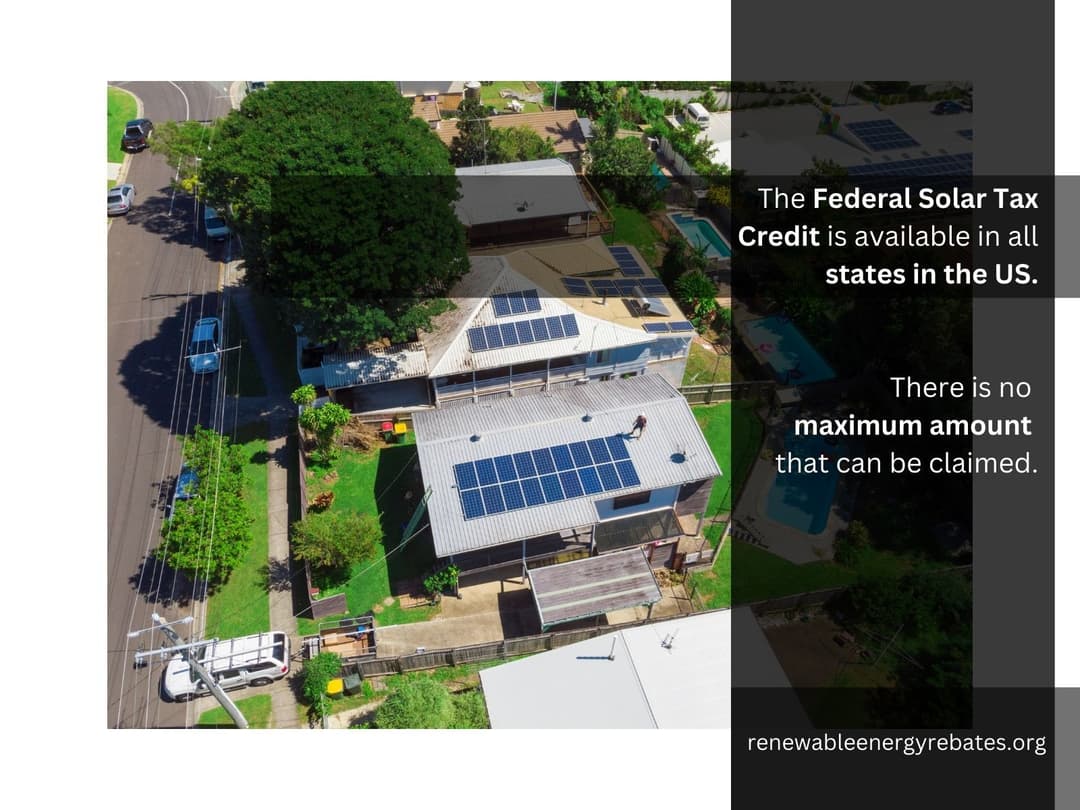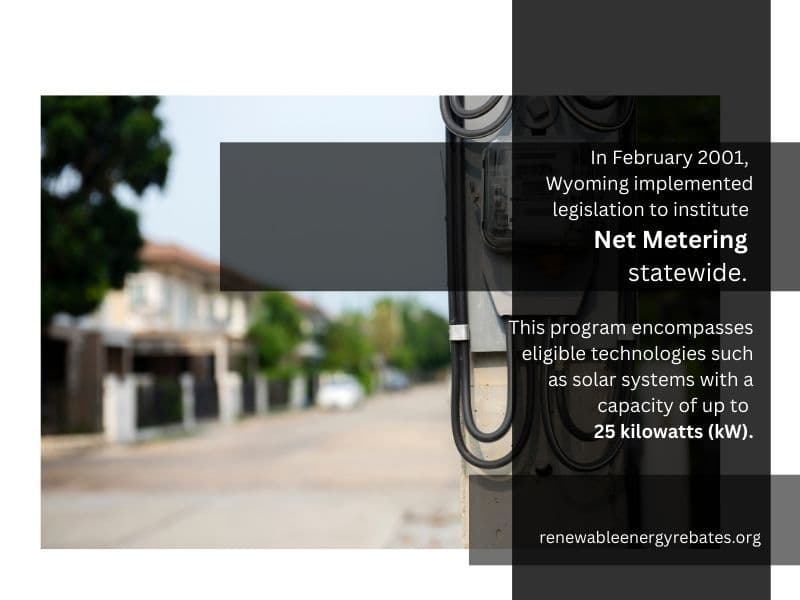Wyoming Solar Rebates and Incentives
How Much Can You Save on Solar in Wyoming?
Key Details
- Wyoming has a federal Solar Tax Credit program covering 30% of PV system installation costs
- Wyoming residents can get a 50% rebate up to $3,000 for installing PV systems in residences .
- Wyoming's total energy consumption per capita is 874 million BTUs
- 71.7% of housing units in Wyoming are owner-occupied with a median value of $237,900.
Wyoming Energy Profile
According to the U.S. Department of Energy, Wyoming consumed an average of 17 terawatts per hour in 2021. The state ranks among the lowest energy consumers, using less than one percent of the country's total energy consumption..
Federal and State Solar Incentives available in Wyoming
| Wyoming Solar Incentives | State or Federal | Program Overview |
| Federal solar tax credit | Federal | The program covers 30 percent of the cost of installing a PV system. Residential and commercial solar owners can apply for this incentive on their annual tax returns. |
| Rural Energy for America Program (REAP) | Federal | REAP offers a 25 percent grant to cover solar installation in schools, public power entities, and government buildings. |
| State Residential Rebate | State | Residential solar users will receive a 50 percent rebate up to $3,000. |
Wyoming generates 49.6 TWh per hour from both renewable and non-renewable energy sources. Still, the state gets most of its electricity from nonrenewable energy sources, such as fossil fuels.
For example, coal-powered power plants generated 73 percent of the state's electricity demand. Also, less than 5% of the electricity used in the state comes from natural gas and hydroelectric plants.
Although Wyoming has one of the highest petroleum usage rates per capita, it does not depend on it to generate electricity. The transportation sector is the major user of gasoline in the state.
Federal Solar Tax Credit in Wyoming
The federal solar tax credit is an incentive that covers 30 percent of the cost of solar installation. You can request for this incentive when you file your annual tax returns.
For example, if your PV system has an installation cost of $20,000, solar users can request for a $6,000 write off from their annual tax. Sometimes, you may need to carryover this tax credit to the next tax year. According to the IRS, you must rollover the tax credit if it exceeds your income tax liability.
That said, the federal income tax credit has different phases. These phases may determine how much you get as a tax credit. So, here's the phase schedule:
- PV Systems installed between 2022 and 2032 will get a 30 percent tax credit.
- PV systems installed in 2032 will get a 26 percent federal solar tax credit.
Most of Wyoming's solar energy comes from the 92-megawatt Sweetwater Solar farm.

So, what expenses will the solar investment tax credit cover?
The federal solar tax credit covers expenses for these equipment:
- Solar batteries with a storage capacity of up to 3 kWh.
- Solar panels, inverters, and use taxes on the equipment.
- Sales tax on eligible solar equipment.
- Labor costs, including cost of onsite preparation, permit fees, inspect costs, and cost of assembling the panel.
- Additional cost includes expenses on set-up transformers, circuit breakers, and surge arrestors.
The renewable energy incentive also covers expenses on wiring and mounting equipment.
Eligibility
The federal solar tax credit is accessible to all solar users. To access this incentive, you must fulfill all of these criteria:
- You must own the home where the unit is installed.
- You must own the panel, and it must be new or still in good condition.
- The solar panel is installed in the U.S. or any of its territories.
Note: Tenants or stockholders in a cooperative housing corporation can also obtain the federal solar tax credit.
How do I claim the Federal Solar Tax Credit in Wyoming?
Follow these steps to claim the federal solar tax credit in Wyoming.
- Step 1. Visit the IRS web site and print out Form 5695. The form covers all the guidelines for filling out a solar tax credit. Note that there are specific instructions for completing Part I (Residential Clean Energy Credit) and Part II (Energy Efficient Home Improvement Credit).
- Step 2. Fill out Line 1 and other sections on the form. The Line 1 section is where you calculate the 30 percent tax credit in cash amounts. Check your invoice for the full cost of installation. You should also input the contact information of the solar company that installed the panel.
Note: fill out the Line 12 if there are tax credit rollovers from the previous year.
File the Form 5695 along with the Form 1040. You can file the tax form via mail to:
Department of the Treasury
Internal Revenue Service
Ogden, UT 84201-0002
Internal Revenue Service
P.O. Box 802501
Cincinnati, OH 45280-2501
Net Energy Metering in Wyoming
Wyoming's legislators established a statewide net metering program in 2001. Unlike Wyoming's solar panel tax credit, this program provides renewable energy users with consistent income.
Net metering is a billing contract in which solar users receive credits for generating electricity. Investor-owned utility companies are on the other side of the contract, and they are the "buyers" of extra credits.
Here's a breakdown of how net metering works in Wyoming.
Laurie's solar energy system generates $1,500 worth of power per month. However, she only used about $1,000 worth of energy in that month. Since she's connected to the grid, the utility company will pay her for the excess energy produced. Note that utility companies pay in credits. This credit is rolled over to the next month.
At the start of every calendar year, the utility company will pay all unused credits in cash.

How to Enroll for Net Energy metering in Wyoming
Wyoming residents can enroll in net metering by sending an "interconnection" request to an utility company.
Each Wyoming electric utility company has its own set of guidelines for participating in net metering. However, most residents can enroll for net metering using the following general steps;
- Step 1. Choose a Wyoming solar installer that can design the PV system according to the utility company's requirements. Your PV system must comply with IEEE 1547 and UL 1741. Also, ensure your PV system has a power capacity of less than 25 kWh.
- Step 2. Complete an interconnection agreement online. The utility company will review and notify you of any fees and taxes to pay. It takes 15 to 30 business days for the company to review an application.
- Step 3. Pay the required fees and taxes to get approval. Rocky Mountain Power will send an approval via mail.
- Step 4. Install the PV system and get it inspected by the electrical inspector in your location.
- Step 5. Send the electrical inspection approval form to the utility company. Rocky Mountain will install a meter within ten days of getting the approval form.
Wyoming Property Tax Exemption
In April 2022, Wyoming implemented a statewide exemption on property taxes for installed solar systems. Virginia's Governor Glenn Youngskin signed Virginia S.B. 686 to exempt solar installations from property tax. The law classifies solar installations below 25 kWh as a "separate property".
Systems installed in 2032 are eligible for a 22 percent tax credit. Those who install in 2034 will not receive a tax credit.
Wyoming Household Profile
Wyoming's total energy consumption is 874 million BTUs per capita, according to the Energy Information Administration's 2020 report. Furthermore, these are the energy consumption per capita for each sector in the state.
| Wyoming's Sectors | BTUs consumed per capita |
| Residential | 90.1 |
| Commercial | 92.4 |
| Industrial | 505.4 |
Note: the British Thermal Unit (BTU) is the measure of heat required to increase a pound of water (16 fluid ounces by one Fahrenheit. Also, a million BTUs provide the same energy as eight gallons of gasoline.
As of 2021, there were 274,371 housing units in Wyoming. About 71.7% of these units are owner-occupied with a median value of $237,900. These owner-occupied units are eligible for Wyoming’s tax credit for solar panels.
Furthermore, the state issued 2,706 building permits in the same year. This means more residential and commercial units will be constructed within the next few years. That said, these units may install PV systems to reduce demands on fossil-based energy. As mentioned in the previous section, Wyoming relies heavily on non-renewable energy sources.
What are the major renewable energy sources in Wyoming?
Hydroelectric power, wind energy, and solar energy are the major sources of renewable energy in the state. The Cowboy state generates 19 percent of its electricity demand from wind farms along the state's mountain pass.
By 2021, the state would have installed wind farms with a generating capacity of over 3,000 megawatts. In addition, the 3,000-megawatt Chokecherry-Sierra Madre project has an estimated 2025 completed date. This project will be powered by 900 turbines, and the state may consider exporting this energy to neighboring states.
Wyoming has 70 small-scale dams, which contribute about 2 percent to the state's electricity generation.
As of 2023, solar energy is the least popular renewable energy source in the state.
Solar energy contributes two percent of the state's total renewable energy production. There are also consumer-owned solar systems in Wyoming. State residents can apply solar energy incentives, such as a federal solar tax credit. These incentives help to offset the cost of installing PV systems.
Geothermal pumps are also a renewable energy source in Wyoming. Although the state is yet to commercialize it, geothermal is used for direct heating. This energy is currently used to heat the Hot Springs State Park, Yellowstone National Park, and other buildings.